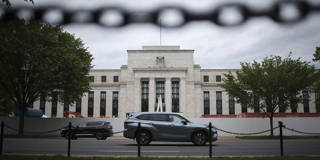The first-quarter GDP report supports the view that the US economy has not landed. While some economists are concerned about stagflation, the real worry is that taming price pressures may require a mild downturn, given strong consumer spending and inadequately restrictive monetary policy.
WASHINGTON, DC – In the first quarter of 2024, GDP in the United States grew at an annual rate of 1.6% – nearly a percentage point slower than expected. At the same time, core inflation remained higher than anticipated, with consumer prices (excluding energy and food) increasing at an annual rate of 3.7%, up from 2% in the fourth quarter of 2023.
At the time of writing, stock prices are falling and bond yields are climbing on the expectation that the US Federal Reserve will deliver only one interest-rate cut in 2024. This represents a remarkable shift from the end of 2023, when markets expected the Fed to lower rates six times in 2024. Over the first quarter of this year, investors slashed their bets on rate cuts to make way for the view that strong growth and stickier inflation would persist. Now, there is evidence of slowing growth and high inflation, a combination that has prompted some investors and analysts to warn of stagflation.
How should we connect the dots? Is the US economy still booming? Or should we be concerned about a period of slow growth and high inflation?

WASHINGTON, DC – In the first quarter of 2024, GDP in the United States grew at an annual rate of 1.6% – nearly a percentage point slower than expected. At the same time, core inflation remained higher than anticipated, with consumer prices (excluding energy and food) increasing at an annual rate of 3.7%, up from 2% in the fourth quarter of 2023.
At the time of writing, stock prices are falling and bond yields are climbing on the expectation that the US Federal Reserve will deliver only one interest-rate cut in 2024. This represents a remarkable shift from the end of 2023, when markets expected the Fed to lower rates six times in 2024. Over the first quarter of this year, investors slashed their bets on rate cuts to make way for the view that strong growth and stickier inflation would persist. Now, there is evidence of slowing growth and high inflation, a combination that has prompted some investors and analysts to warn of stagflation.
How should we connect the dots? Is the US economy still booming? Or should we be concerned about a period of slow growth and high inflation?